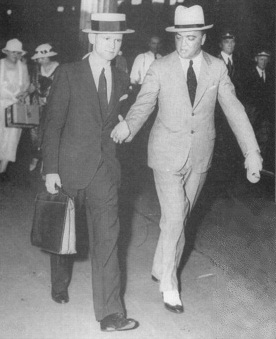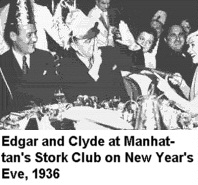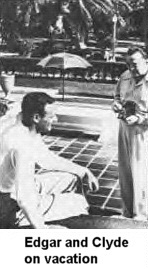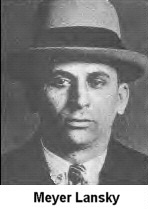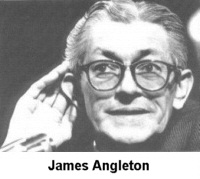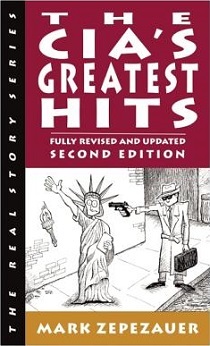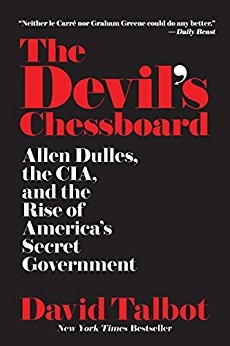|
J. EDGAR HOOVER Homosexual Allegations and Mafia Blackmail
J. Edgar Hoover headed the Federal Bureau of Investigation for 48 years, from 1924 until his death in 1972. With his death, it was disclosed that Hoover had seriously abused his power during his tenure as FBI Director. Some of the most outrageous abuses concerned Hoover's use of FBI surveillance agents to obtain defamatory information--much of it sexual--on prominent persons to be used for political and blackmail purposes. Former Secretary of State Dean Rusk would later say: "Hoover passed along gossip to the President he served, and that practice could raise questions in a President's mind. What did Hoover know about him? In theoretical terms, that put Hoover in the position of a veiled blackmailer." In the case of Martin Luther King, Jr. the blackmail was not veiled, but veritable, with Hoover threatening to make information he had on King public. In the book Official and Confidential, author Anthony Summers presents evidence that Hoover had the tables turned on him and was subjected to blackmail by both the Mafia and the CIA.
The following text is excerpted from the book, Official and Confidential: The Secret Life of J. Edgar Hoover by Anthony Summers.
Mafia boss, Joseph Bonanno, articulated the principles of the game. It was a strict underworld rule, he said, never to use violent means against a law enforcement officer. "Ways could be found," he said in his memoirs, "so that he would not interfere with us and we wouldn't interfere with him." The way the Mafia found to deal with Edgar [Hoover], according to several mob sources, involved his homosexuality. The mob bosses had been well placed to find out about Edgar's compromising secret, and at a significant time and place. It was on New Year's Eve 1936, after dinner at the Stork Club, that Edgar was seen by two of Walter Winchell's guests holding hands with his lover, Clyde [Tolson]. At the Stork, where he was a regular, Edgar was immensely vulnerable to observation by mobsters. The heavyweight champion Jim Braddock, who also dined with Edgar and Clyde that evening, was controlled by Costello's associate Owney Madden. Winchell, as compulsive a gossip in private as he was in his column, constantly cultivated Costello. Sherman Billingsley, the former bootlegger who ran the Stork, reportedly installed two-way mirrors in the toilets and hidden microphones at tables used by celebrities. Billingsley was a pawn of Costello's, and Costello was said to be the club's real owner. He would have had no compunction about persecuting Edgar, and he loathed homosexuals.
Seymour Pollock, an associate of Meyer Lansky's, said in 1990 that Edgar's homosexuality was "common knowledge" and that he had seen evidence of it for himself. "I used to meet him at the racetrack every once in a while with lover boy Clyde, in the late forties and fifties. I was in the next box once. And when you see two guys holding hands, well come on! . . . They were surreptitious, but there was no question about it." Jimmy "The Weasel" Fratianno, the highest-ranking mobster ever to have "turned" and testified against his former associates, was at the track in 1948 when Frank Bompensiero, a notorious West Coast mafioso, taunted Edgar to his face. "I pointed at this fella sitting in the box in front," Fratianno recalled, "and said, 'Hey, Bomp, lookit there, it's J. Edgar Hoover.' And Bomp says right out loud, so everyone can hear, 'Ah, that J. Edgar's a punk, he's a fuckin' degenerate queer.'" Later, when Bompensiero ran into Edgar in the men's room, the FBI Director was astonishingly meek. "Frank," he told the mobster, "that's not a nice way to talk about me, especially when I have people with me." It was clear to Fratianno that Bompensiero had met Edgar before and that he had absolutely no fear of Edgar. Fratianno knew numerous other top mobsters, including Jack and Louis Dragna of Los Angeles and Johnny Roselli, the West Coast representative of the Chicago mob. All spoke of "proof" that Edgar was homosexual. Roselli spoke specifically of the occasion in the late twenties when Edgar had been arrested on charges of homosexuality in New Orleans. Edgar could hardly have chosen a worse city in which to be compromised. New Orleans police and city official were notoriously corrupt, puppets of an organized crime network run by Mafia boss Carlos Marcello and heavily influenced by Meyer Lansky. If the homosexual arrest occurred, it is likely the local mobsters quickly learned of it. Other information suggests Meyer Lansky obtained hard proof of Edgar's homosexuality and used it to neutralize the FBI as a threat to his own operations. The first hint came from Irving "Ash" Resnick, the Nevada representative of the Patriarcha family for New England, and an original owner-builder of Caesars Palace in Las Vegas. As a high-level mob courier, he traveled extensively. In Miami Beach, his Christmas destination in the fifties, he stayed at the Gulfstream, in a bungalow next to the one used by Edgar and Clyde. "I'd sit with him on the beach ever day," Resnick remembered. "We were family."
In 1971, Resnick and an associate talked with the writer Pete Hamill in the Galeria Bar at Caesars Palace. They spoke of Meyer Lansky as a genius, the man who "put everything together,"--and as the man who "nailed J. Edgar Hoover." "When I asked what they meant," Hamill recalled, "they told me Lansky had some pictures--pictures of Hoover in some kind of gay situation with Clyde Tolson. Lansky was the guy who controlled the pictures, and he had made his deal with Hoover--to lay off. That was the reason, they said, that for a long time they had nothing to fear from the FBI."
Seymour Pollock, the criminal who saw Edgar and Clyde holding hands at the races, knew both Resnick and Lansky well. When Lansky's daughter had marital problems, it was Pollack who dealt with her husband. He and Lansky went back to the old days in pre-revolutionary Cuba, when Havana was as important to the syndicate as Las Vegas. "Meyer," said Pollock in 1990, "was closemouthed. I don't think he even discussed the details of the Hoover thing with his brother. But Ash was absolutely right. Lansky had more than information on Hoover. He had page, chapter and verse. One night, when were were sitting around in his apartment at the Rosita de Hornedo, we were talking about Hoover, and Meyer laughed and said, 'I fixed that son of a bitch, didn't I?'" Lansky's fix, according to Pollock, also involved bribery--not of Edgar himself, but men close to him. Lansky and Edgar frequented the same watering holes in Florida. Staff at Gatti's restaurant in Miami Beach recall that the mobster would sometimes be in the restaurant, at another table, at the same time as Edgar and Clyde. One evening in the late sixties, they were seated at adjoining tables. "But they just looked at one another," recalled Edidio Crolla, the captain at Gatti's. "They never talked, not here." If Edgar's eyes met Lansky's, though, there was surely an involuntary flicker of fear. "The homosexual thing," said Pollock, "was Hoover's Achilles' heel. Meyer found it, and it was like he pulled strings with Hoover. He never bothered any of Meyer's people. . . . Let me go way back. The time Nevada opened up, Bugsy Siegel opened the Flamingo. I understand Hoover helped get the okay for him to do it. Meyer Lansky was one of the partners. Hoover knew who the guys were that whacked Bugsy Siegel, but nothing was done." (Siegel was killed, reportedly on Lansky's orders, in 1947.) According to Pollock, Lansky and Edgar cooperated in the mid-fifties, when Las Vegas casino operator Wilbur Clark moved to Cuba. "Meyer brought Clark down to Havana," Pollock said. "I was against him coming. But I understand Hoover asked Meyer to bring Clark down. He owed Clark something. I don't know what. . . . There was no serious pressure on Meyer until the Kennedys came in. And even then Hoover never hurt Meyer's people, not for a long time." Like Frank Costello, Lansky did seem to be untouchable--a phenomenon that triggered suspicions even within the Bureau. "In 1966," noted Hank Messick, one of Lansky's biographers, "a young G-Man assigned to go through the motions of watching Meyer Lansky began to take his job seriously and develop good informers. He was abruptly transferred to a rural area in Georgia. His successor on the Lansky assignment was an older man who knew the score. When he retired a few years later, he accepted a job with a Bahamian gambling casino originally developed by Lansky." Also in the sixties a wiretap picked up a conversation between two mobsters in which, curiously, Lansky was referred to as "a stool pigeon for the FBI." The Royal Canadian Mounted Police, taping a conversation between a criminal in Canada and Lansky in the United States, were amazed to hear the mob chieftain reading from an FBI report that had been written the previous day. There was no serious federal effort to indict Lansky until 1970, just two years before Edgar died. Then, it was the IRS rather than the FBI that spearheaded the investigation. Even the tax evasion charges collapsed, and Lansky lived on at liberty until his own death in 1983. New information indicates that Lansky was not the only person in possession of compromising photographs of Edgar. John Weitz, a former officer in the OSS, the predecessor of the Central Intelligence Agency, recalled a curious episode at a dinner party in the fifties. "After a conversation about Hoover," he said, "our host went to another room and came back with a photograph. It was not a good picture and was clearly taken from some distance away, but it showed two men apparently engaged in homosexual activity. The host said the men were Hoover and Tolson. . . ." Weitz would not say who his host was on the evening he saw the picture. He implied, however, that the host also had intelligence connections. A source who has been linked to the CIA, electronics expert Gordon Novel, claimed he was shown similar pictures by another OSS veteran, CIA Counter-Intelligence chief James Angleton. [Note: In 1994, after publication of Anthony Summers' book, Official and Confidential, Weitz confirmed to Summers that his host was James Angleton.]
"What I saw was a picture of him giving Clyde Tolson a blowjob," said Novel. "There was more than one shot, but the startling one was a close shot of Hoover's head. He was totally recognizable. You could not see the face of the man he was with, but Angleton said it was Tolson. I asked him if they were fakes, but he said they were real, that they'd been taken with a fish-eye lens. They looked authentic to me. . . ." According to Novel, the CIA Counter-Intelligence chief showed him the pictures in 1967, when Novel was involved in the furor swirling around the probe into the investigation of the assassination of President Kennedy by New Orleans District Attorney Jim Garrison. "I was pursuing a lawsuit against Garrison, which Hoover wanted me to drop but which my contacts in the Johnson administration and at CIA wanted me to pursue. I'd been told I would incur Hoover's wrath if I went ahead, but Angleton was demonstrating that Hoover was not invulnerable, that the Agency had enough power to make him come to heel. I had the impression that this was not the first time the sex pictures had been used. Angleton told me to go see Hoover and tell him I'd seen the sex photographs. Later, I went to the Mayflower Hotel and spoke to Hoover. He was with Tolson, sitting in the Rib Room. When I mentioned that I had seen the sex photographs, and that Angleton had sent me, Tolson nearly choked on his food. Hoover told me something like, 'Get the hell out of here!' And I did. . . ." With Angleton dead, there is no way to follow up this bizarre allegation. While Novel is a controversial figure, his account of seeing compromising pictures must be considered in light of other such references--not least that of former OSS officer John Weitz. For Novel added one other significant detail, that "Angleton told me the photographs had been taken around 1946, at the time they were fighting over foreign intelligence, which Hoover wanted but never got." During his feud with OSS chief William Donovan, dating back to 1941, Edgar had searched for compromising information, sexual lapses included, that could be used against his rival. His effort was in vain, but Donovan--who thought Edgar a "moralistic bastard"--reportedly retaliated in kind by ordering a secret investigation of Edgar's relationship with Clyde. The sex photograph in OSS hands may have been one of the results. It may be significant, too, that compromising pictures are reported as having been in the hands of both the OSS and Meyer Lansky. The OSS and Naval Intelligence had extensive contacts with the Mafia during World War II, enlisting the help of criminals in projects including the hiring of burglars and assassins, experimentation with drugs, the protection of American ports from Nazi agents and the invasion of Sicily. Lansky helped personally with the latter two operations, meeting with Murray Gurfein, a New York Assistant District Attorney who later became one of Donovan's most trusted OSS officers. At least once, Lansky worked alongside U.S. intelligence officers on exactly the sort of operation likely to turn up smear material on prominent public men. In 1942, he arranged for the surveillance of a homosexual brothel in Brooklyn suspected of being the target of German agents. "Clients came from all over New York and Washington," Lansky recalled, "and there were some important government people among them. . . . If you got hold of the names of the patrons you could blackmail them to death . . . take some pictures through a hole in the wall or a trick mirror and then squeeze the victim for money or information." There is no knowing, today, whether the OSS obtained sex
photographs of Edgar from Lansky, or vice versa, or whether the mobster
obtained them on his own initiative. A scenario in which Lansky
obtained pictures thanks to the OSS connection would suggest an
irony: that Edgar had tried and failed to find smear material on
General Donovan, that Donovan in turn found smear material on him and that
the material found its way to a top mobster, to be used against Edgar for
the rest of his life. Resources:
|
